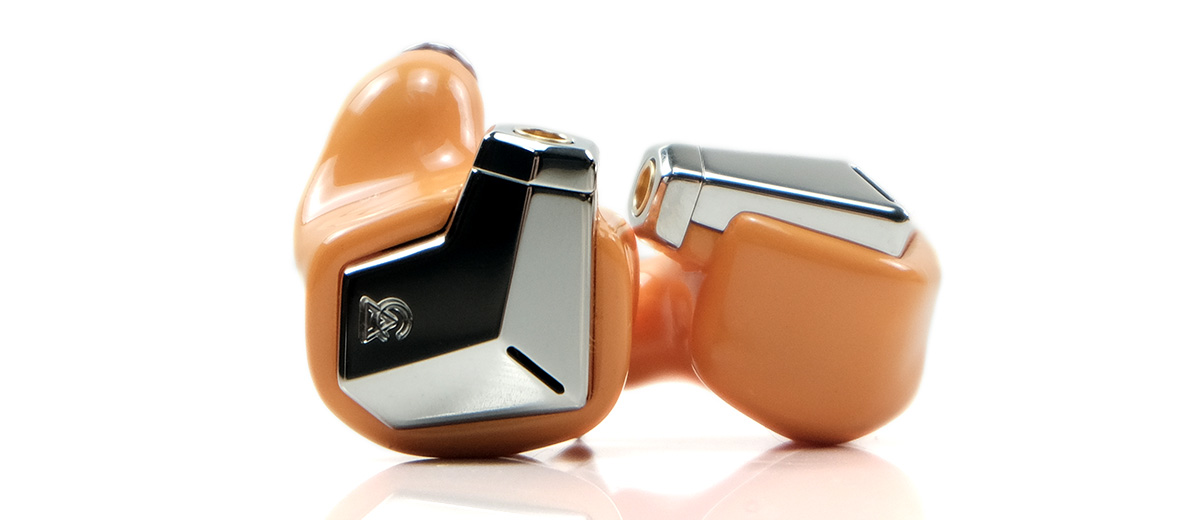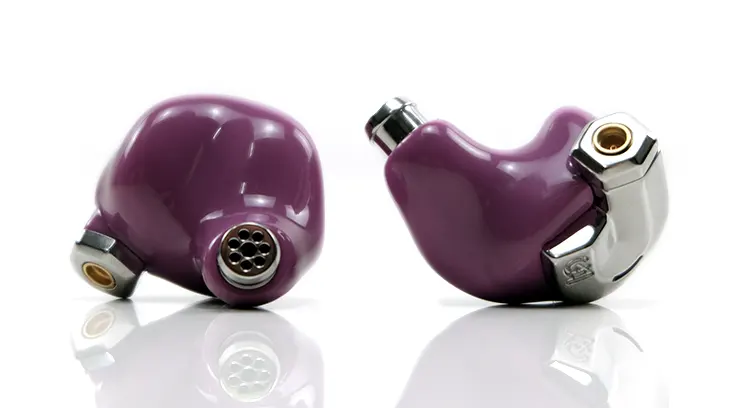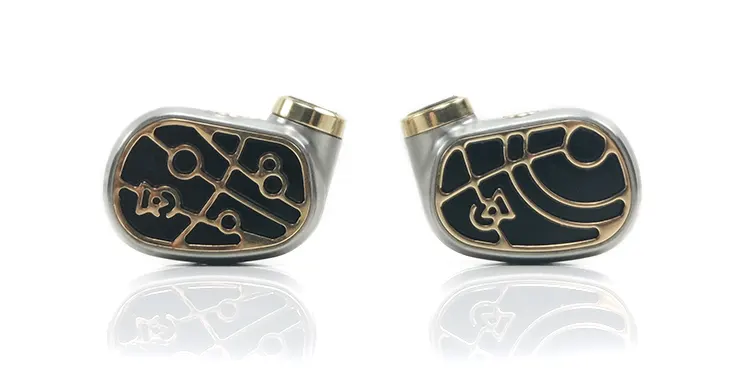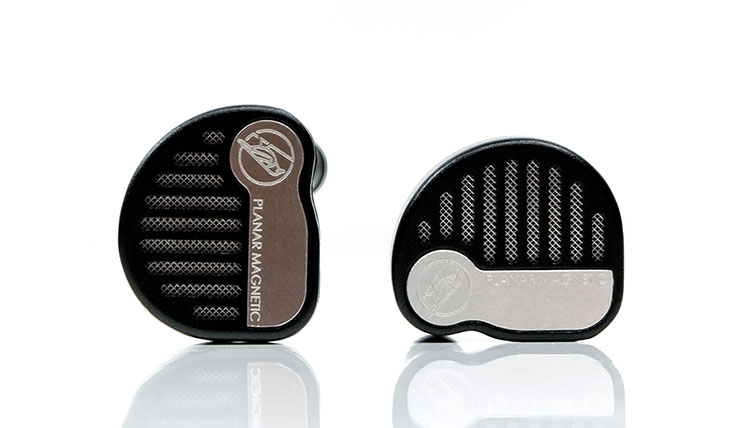Select Comparisons
The following comparisons to the Campfire Audio Supermoon were completed using a mix of the HiBy R8 II, the iBasso DX320 with AMP12, and the LP P6 Pro as the main sources.
Campfire Audio Bonneville
The Campfire Audio Bonneville was launched last year as the flagship in-ear monitor of the company’s newly formed Chromatic Series of IEMs. You can read our recent full review of the Bonneville here.
Technical
The Bonneville takes a very different path to the Supermoon with a hybrid mix of dynamic and BA drivers as opposed to a simpler single 14mm full-range planar driver setup.
Inside it uses a single 10mm dynamic and 3 balanced armature drivers. The precise configuration is a dual-magnetic 10mm dynamic driver for the lows, a single BA for the mids, and a dual BA for the highs.
The midrange BA driver is the new Knowles’ new dual-diaphragm armature with RLQ technology which allows CA to reduce the acoustic space required and maximize the output power at the same time.
The Bonneville requires 14.59 mVrms to reach 94 dB @ 1 kHz for SPL and has an impedance rating of 29Ω @ 1 kHz so neither has load issues but the Supermoon is less efficient requiring 54 mVrms to hit that 94 dB @ 1 kHz equivalent.
You will find yourself bumping up the volume of your source considerably more for the Supermoon.
Design
These are very similar design concepts with form factors not too far off each other either. Aside from the completely different color scheme, the physical differences are quite subtle.
For example, the chrome plate on the Bonneville is raised a bit higher compared to the Supermoon version and it also has a curvier shape with the narrow venting slit in a slightly different position.
I did notice a difference in the fitting which means the precise shape and contouring are slightly changed on the Supermoon compared to the Bonneville. The former felt a better fit for my ear compared to the latter, even with matching silicone tips.
The isolation also proved to be superior for the Supermoon though again, this is anecdotal based on my ear shape meaning that might not be the case for your ears.
The weight from the planar driver and magnet array inside the Supermoon is slightly more than the Bonneville which is something you might also notice when they are in your ear.
Save for the different color schemes, everything else is the same including the Time Series cable choice, the packaging, and the accessories, be it Essential or Deluxe Editions.
Performance
Some big differences here but as to which one you should get the answer is it depends. That is not fence sitting here but rather they bring so many differences that to have them side by side as a different set of tools for different moods and genres is the more appropriate stance.
That said, not many have the luxury of being able to get both so to be clear and succinct; the Supermoon is more balanced sounding, with a firmer, better-textured sub-bass and a forward 1-3k midrange with more vocal bloom and perceived separation.
The Bonneville is slightly smoother with a stronger dynamic driver punch and slam and a more articulate set of highs. However, it also has more upper bass bloom and warmth combined with less midrange presence compared to the Supermoon.
The Supermoon has a more flexible turning and will suit a wider range of genres. It is especially good at teasing out vocal presence and works wonderfully well with classic rock. Its lack of upper-bass bloom allows lower mids and vocals more room to shine.
For the Bonneville, its forte is modern pop, R’n’B, and anything with a driving rhythm. It is more suited to higher-pitching vocals on sparser mixes where there is a clear space in the mix between the bass and midrange energy. It casts a taller soundstage though I think the Supermoon has the edge in sheer depth.
Overall, my preference is the Supermoon’s more consistent performance over a wider range of styles of music. However, on a technical level, Bonneville’s dynamics are more convincing and those BA tweeters articulate the highs nicely giving it a more explosive high-energy character.
Campfire Audio Solaris Stellar Horizon
The Solaris Stellar Horizon was launched in early 2023 with our review in mid-2023. It sits outside the Chromatic series with its origins from the Solaris series and sits a step higher in the company’s IEM lineup.
Technical
The Stellar Horizon is another hybrid IEM design, this time a 4-driver design with a single dynamic driver for the lows, and 3 BA for the mids and highs using a single crossover.
The choice of the dynamic driver is more ‘Campfire Audio traditional’ with the implementation of the A.L.D.C. 10mm dynamic driver used by several other CA IEMs down through the years.
The new custom midrange dual-diaphragm Knowles driver with dual tweeters for the highs is used by both monitors. However, unlike the Bonneville the Stellar Horizon uses T.A.E.C. tubeless technology for the Tweeters.
As far as I am aware the Stellar Horizon does not use CA’s Solid-Body built-in geometry that helps to tune and accent the drivers which the Supermoon does use.
The Solaris Stellar Horizon is the easiest of the two IEMs to drive at 4.4Ω with a 9.145 mVrms rating to obtain a benchmark of 94 dB SPL @ 1kHz. You will find the Supermoon a more demanding IEM to achieve adequate listening levels at 54 mVrms to hit that 94 dB @ 1 kHz equivalent.
Neither needs huge voltage to drive them adequately so it’s more about good gain levels from a decently powered dongle or DAP with the Supermoon.
Design
The Horizon has the classier looks. The two-piece precision machined brushed stainless steel housing is also far more durable compared to acrylic. However, you can mold an acrylic body more aggressively with the resulting form factor a more accurate fit.
I give an edge to the aesthetics of the Stellar Horizon but appreciate this is entirely subjective. The craftsmanship is more intricate and the materials required are likely to be more costly to acquire. The rune-like design work on the faceplates in particular is gorgeous.
I have a bias for the orange of the Supermoon but if you opt for the black version it is an aesthetic that has been used before in the CA customs designs so it’s not quite as unique.
For isolation, it will depend on the tips you use since they both come with the same tips. Doing a like-for-like on the silicone tips gave the Supermoon a distinct advantage. However, if I switch to both using a 3rd party Final E tip the isolation performance is about equal.
The reason for that is the form factor with the shorter nozzle extension and more uniform shape of the Stellar Horizon putting more emphasis on the tip doing the isolation work. Thus, the tip choice has to be really good to get matching isolation levels whereas the Supermoon only needs the stock tips to compete.
Both IEMs come with Time Series cables but the aluminum barrel finishing on the Stellar Horizon versions are of a higher grade. Only the Deluxe version of the Supermoon comes with the same triple cable count whereas with the Horizon you get the three cables by default.
Performance
Of the two, the Stellar Horizon is the more neutral and reference-like in its coloration. It’s lighter sounding on the lows but it’s also tighter with a more prominent mid-bass punch and less of a lower-mids dip around 500-800Hz.
The Supermoon delivers the bass bombs in comparison. It’s much more elevated by at least 6-8 dB over the Stellar Horizon up to 50Hz and still around 3-4 dB more presence up to 100Hz.
This is one of the dominant features of its tuning injecting all timbre through and beyond with a stronger fundamental and a denser note tone. In contrast, the Stellar Horizon note density is lighter, with a shorter decay, but with more perceived detail and headroom in the highs where the energy post-8k is stronger.
Supermoon’s vocal positioning is further forward and you will notice the more relaxed imaging of the Steller Horizon equivalent.
However, once the Supermoon’s bass goes into overdrive it has less of a forward feel with the Horizon’s more spacious mids and highs offering a bit more focus on subtle detail or shifts in vocal positioning.
Resolution in the mids and highs is in the Horizon’s corner. Those BA drivers articulate a bit more and can weave a more complex staging quality the further up you go. The Supermoon forte is really the enticing texture within the notes and the detail they convey.
I would pick the Supermoon over the Horizon if you need power, a planted-sounding rhythmic presentation, and a more soulful sound to your vocal delivery. The Horizon is more about the detail, the speed, and delivering a more complex presentation, particularly through the highs.
AAW Nightingale
The AAW Nightingale was launched in 2019 and reviewed by us in the same year. It is still listed as the company’s main planar driver IEM in its product line with a similar pricing point to the Supermoon.
Technical
Both of these are planar magnetic driver IEMs but there is one significant difference with the Nightingale using an open-back design. Whereas the Supermoon is a more traditional closer in-ear format with venting.
The Nightingale uses a slightly larger 15mm MPMTM micro planar magnetic driver with a grade thin film diaphragm and a miniature Neodymium magnetic array. The internal wiring is finished with UPOCC Copper which is just the thing AAW/Null Audio would do given they are also a cable company.
The Nightingale rated in the traditional format at 26Ω impedance and 105 dB @1Khz (presuming mW) so it’s a bit challenging to directly compare on paper to the Supermoon’s 54 mVrms to hit that 94 dB @ 1 kHz equivalent.
However, subjectively and using the HiBy R8 II’s Turbo mode balanced output in a low gain setting the Supermoon is the more sensitive of the two monitors by around 10 steps at a minimum.
Design
By default, the open-back nature of the Nightingale gives it a cool front profile aesthetic with its Noire-like open grill pattern. It is quite a contrast to the Supermoon’s loud and proud pastel orange visual.
It is a similar contrast for the main shells with the smaller Nightingale built with CNC-machined aluminum and the bulkier but lighter Supermoon using a more contoured 3D-printed resin mold.
Both IEMs fit quite well, though the Nightingale relied a little more on the tips doing the last mile for seal and secure fitting whereas the Supermoon’s contoured shell leverages the shape of your ear to create a more secure fit without relying too much on the tips.
That being said, the open-back nature of the Nightingale does mean regardless of tips it will not isolate as well as the Supermoon. I tend to use its stock bi-flange tips also to get a more secure fit which are much taller than the stock silicone wide bore tips that come with the Supermoon.
Cable choices between these two are a cut above the average. AAW will only supply one cable as opposed to three inside the Deluxe Edition of the Supermoon. However, the Essential package price of the Supermoon is much closer to the Nightingale price which is a fairer comparison.
The Nightingale comes with Null Audio’s Symphonym Tiburon UPOCC Copper Cable. It has a 1.2m 4-wire 26AWG UPOCC Litz wire geometry insulated in a transparent thermoplastics jacket.
It is a more traditional braided cable in its outward appearance compared to the flat nature of the 8-core SPC CA Time Series cables but also a little bit lighter. Handling is better on the Time Series cables due to the flat design.
Performance
The Nightingale is much more N-shaped in its frequency response curve with diminution on both ends of the spectrum giving vocals a central focus in most of my listening with it down through the years.
In contrast, the Supermoon has a stronger bass elevation, less lower-mid warmth, and relatively similar vocal forwardness but importantly, a stronger treble tuning.
I say importantly because that is the Nightingale’s weak spot with a 3-10k tuning that, aside, from a minor 7k peak, is largely south of neutral giving the tuning a much darker sound. There is very little upper-order harmonic influence meaning notes are quite rounded and it suffers from a lack of headroom and air.
That is the big strength of the Supermoon. Despite a much weightier bass response and equally forward mids, that dip in the lower mids, combined with the better 4-10k energy produces a clearer presentation with improved treble overtones on the mids timbre.
Thus, you get a much better harmonic balance to the Supermoon notes, more air, and superior instrumental separation. That benefits the dynamic range also with more space for each note to be clearly heard even when the bass attack is very strong.
It is amazing just how far IEM drivers have developed in the last 3-4 years with this being a very good example. At the time, the Nightingale driver was one of the best out there but technically, it is very far behind the likes of the Supermoon now.
Our Verdict
Whilst I recognize the fun, energy, and technical excellence of both the Bonneville and the Stellar Horizon, I am more enamored by the balance and flexibility of the Supermoon tuning.
That is a personal preference for sure, you may feel differently depending on what you are looking for. However, the superb low-end weight and body in the performance, the lack of bloat, and the clear vocal presence make this a stand-out offering from Campfire Audio.
If you are after a reference tuning this is not it. If you want delicacy and airy complexity I am not sure the Supermoon is for you either. It is technically very good but its strength is more about mixing power with emotive vocal performances.
If that is your bag, then the Supermoon is an excellent match.
Campfire Audio Supermoon Specifications
- Custom Full-Range 14mm Planar Magnetic Driver
- Frequency Response: 5Hz–20 kHz
- SPL: 94 dB @ 1 kHz: 54 mVrms
- Impedance: 15.5 Ohms @ 1 kHz
- Less than 1% Total Harmonic Distortion






